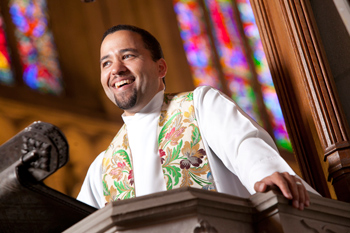Editor’s note: Faith & Leadership offers sermons that shed light on issues of Christian leadership. Nancy S. Taylor delivered this sermon on Dec. 13, 2009, at Old South Church in Boston.
In those days Mary set out and went with haste to a Judean town in the hill country, where she entered the house of Zechariah and greeted Elizabeth. When Elizabeth heard Mary’s greeting, the child leaped in her womb. And Elizabeth was filled with the Holy Spirit and exclaimed with a loud cry, “Blessed are you among women, and blessed is the fruit of your womb. And why has this happened to me, that the mother of my Lord comes to me? For as soon as I heard the sound of your greeting, the child in my womb leaped for joy. And blessed is she who believed that there would be a fulfillment of what was spoken to her by the Lord.”
And Mary said, “My soul magnifies the Lord, and my spirit rejoices in God my Savior, for he has looked with favor on the lowliness of his servant. Surely, from now on all generations will call me blessed; for the Mighty One has done great things for me, and holy is his name. His mercy is for those who fear him from generation to generation. He has shown strength with his arm; he has scattered the proud in the thoughts of their hearts. He has brought down the powerful from their thrones, and lifted up the lowly; he has filled the hungry with good things, and sent the rich away empty. He has helped his servant Israel, in remembrance of his mercy, according to the promise he made to our ancestors, to Abraham and to his descendants forever.” (NRSV)
How did it come to this? How did it happen that Mary, mother of Jesus, got tamed, domesticated? What have we done to her?
Can you see her in your mind’s eye? Can you see how artists have typically painted her? How sculptors have posed her? Can you see in your mind’s eye portraits of Mary in museum galleries? Can you see in your mind’s eye statues of Mary in churchyards and in church sanctuaries? Can you see the bend of her neck? How her head is tilted down? Can you see her hands folded in prayer?
Can you see how serene she is, and gentle, and obliging? She is modest, reserved, meek, humble, demure, obedient and diffident.
How did it come to this? What have we done to her?
Listen again to Mary’s Song: “God has shown strength with his arm. God has scattered the proud. God has brought down the powerful from their thrones. God has lifted up the lowly. God has filled the hungry with good things.” (Fresh avocado and tomato salad? Lobster bisque? Rack of lamb with a nice cabernet?) “God has filled the hungry with good things.” OK so far.
“God has filled the hungry with good things” -- but here’s the rub -- “and sent the rich away empty.” Not even a PB&J sandwich? Not even a single slice of bologna on white? Empty?
Is it your judgment that the pose in which she is typically depicted captures the Mary who sings this song?
This woman of strong song, of defiant doxology -- this first-century woman who breaks through the silence imposed upon most biblical women would more aptly be represented in the pose of a revolutionary: arms raised, leading the people in an uprising for justice!
Too much of the church, too much of the time, has put Mary on a pedestal. She’s been idealized and romanticized. Tamed.
We do that to the great among us, the ones who challenge us -- put them on pedestals to tame them. It happened to Martin Luther King Jr. We put him on a pedestal as the great challenger of racism -- which he was -- but in the process, we have all but dismissed his searing critiques of war and poverty.
Every day on my way to the church I pass a trio, a trinity, of great women.
I pass Lucy Stone, abolitionist and suffragist; and Abigail Adams, spouse of and advisor to the second president; and Phillis Wheatley, born into slavery and later freed, the first published African-American woman and, not least, a member of this church.
These three great women are sculpted in bronze on Commonwealth Avenue. And the thing is, all of them are off their pedestals. Each has a pedestal -- a large, rectangular granite pedestal -- but they have climbed down from them and co-opted their pedestals for better uses.
Abigail leans against hers, her arms crossed.
Phillis, the poet, uses hers for a writing table.
Lucy, contemplating her next speech, rests on hers.
Every spring, when the trees have leafed out and the grass has greened, someone sees to it that Abigail, Lucy and Phillis hold in their hands magnolia blossoms. A little later in the season, someone else sees to it that they are holding purple lilacs.
Later into the summer, women from a salon on nearby Newbury Street pay their annual visit to Lucy, Abigail and Phillis. While they are visiting, they paint the ladies’ nails.
I have seen a sweater draped over Phillis’ shoulders on a chilly day.
It is because these women have climbed down from their pedestals that the rest of us feel free to interact with them -- converse with, learn from and be inspired by them.
If we were to take Mary off the pedestal upon which the church is forever wanting to place her, we’d hear, I think, that Mary does oblige.
Mary does say yes to God. She says yes to bearing the Christ. She says yes to the suffering and heartache that will ensue. Mary says yes.
But here’s the thing: in saying yes to God, Mary also says no.
She says no to things that are ungodly. She says no to the indifference of the wealthy to the plight and pain of the poor. No to wasted limbs and bloated bellies on this bountiful earth. No to the strong taking advantage of the weak. No to the arrogant pride of the powerful.
We’ve been caught, you and I. We’ve been caught rubbernecking, most of us. Maybe not you. Maybe it’s just me.
There was a car accident, an incident, on the lawn outside Tiger Woods’ home, and I’ve been rubbernecking.
There was an incident at the White House: gate crashers in tuxedo and red silk, and we’ve been observed observing them. We’ve been caught rubbernecking.
Mary’s Song is the screech of God’s tires and the blare of God’s horn to we who have been rubbernecking, who have taken our eyes off of matters of consequence.
The song is a horn blast, an attention-getting device: stop rubbernecking and get down to the godly business of big things, important things, matters of consequence, like the relation of the poor to the rich, and how we live together in this city and this nation and on this small, precious, fragile earth.
One of Mary’s titles, given to her by the church, is Queen of Heaven. It’s a shame, really, because this song she sings -- this strong song, this defiant doxology -- is filled less with the things of heaven and very much with the things of this earth: with rich and poor, hunger and food, pride and humility.
The song, in fact, is a song of revolution: of turning, of reversals, the high brought low, the lowly raised up high, the rich made poor, the poor made rich. These are words of revolution.
This is the defiant doxology, the strong song of a peasant woman, an expectant mother, crying out for the future well-being of her peasant child, and Elizabeth’s child, and the other children in the neighborhood who would also be born into poverty and subject to the whims of an occupying army and an occupying empire.
Today, in this sanctuary -- this house and home of God -- today, with the echo of Mary’s strong song still ringing in our ears, we will baptize and confirm and welcome sisters and brothers into this revolutionary enterprise.
This churchly business we are about, this matter of discipleship, is an underground movement, a countercultural movement, a radicalizing movement, an insurgency and rebellion against the status quo, against the rich keeping rich at the expense of the poor.
We come here to train, practice and take our role in this movement. Worship is how we train. Worship is our strategy. Worship is our gymnasium. It is where we develop strong Christian muscles for the living out of our faith.
Do not think for a minute that Christian worship is innocuous, or innocent, or neutral. Christian worship, rightly ordered, is a profoundly subversive enterprise -- one with intentionality.
It is intended to have its way with us and, over time, to subvert all other claims for our fealty, whether national or familial, ethnic or cultural, political or racial. Its purpose is to persuade us to surrender to God until, like Mary, we stand before God and say yes to God and say no to that which is ungodly.
Those whom we will baptize and confirm and welcome -- these are the newest recruits in a movement intended to melt the hearts of the proud, intended to coax weapons from the hands of our leaders, a movement that shows the deepest respect for the poor, a movement that challenges impossibly high interest rates on credit cards, a movement that sets nice tables and serves good food -- lobster bisque, rack of lamb and a nice cabernet -- to those who are hungry.
We are joined in a movement, you and I. We are joined both because Mary said yes to God and because Mary said no to all that is ungodly.














